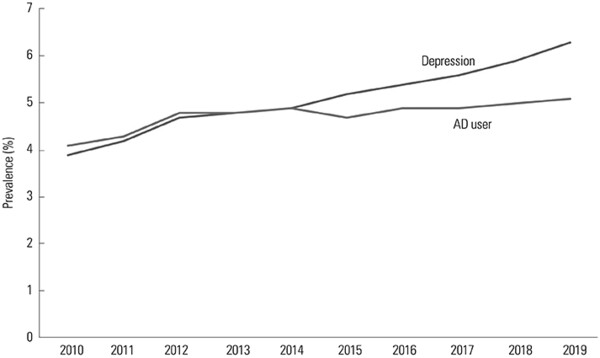The incidence of depression in patients suffering from pain is increasing, a study said. Depression is also associated with mortality, so it is necessary to manage depression in patients with pain conditions.
A team of researchers from Seoul National University Bundang Hospital analyzed data from the National Health Insurance Service from 2010 to 2021. It published its findings in the Yonsei Medical Journal, a Yonsei University College of Medicine publication.
The researchers found that depression and antidepressant use among patients with pain increased from 2010 to 2019.

Among 1,877,234 randomly selected patients with pain from 2010 to 2019, the average rate of depression was 5.1 percent, and that of antidepressant use was 4.8 percent. The incidence of depression accounted for 3.9 percent of 1,880,043 patients with pain in 2010, but the share jumped to 6.3 percent of 1,892,913 patients in 2019.
Antidepressant use also increased from 4.1 percent to 5.1 percent.
To examine the incidence of depression in patients with pain, the researchers analyzed 1,804,019 patients who reported experiencing pain in 2010.
Of the 1,804,019 patients, 70,148 had depression, while 1,733,871 were categorized as the control group who did not suffer from depression.
After comparing the rates of painkiller use and underlying mental and musculoskeletal disorders in the depressed and the control groups, all three items were higher in the depressed group than in the control group and were associated with the development of depression.
In painkillers, for instance, the depressed group showed 3.6 percent in gabapentin or pregabalin use, but the rate was a mere 0.4 percent for the control group. Also, 36.1 percent of depression patients had an anxiety disorder, compared to only 5.3 percent of the control group. Among musculoskeletal disorders, 51.6 percent of depressed patients had low back pain, but the control group’s comparable rate was less than half of it, with 22.5 percent.

Depression also affected patients' survival rates. After comparing 10-year mortality rates for pain patients in 2010, the depressed group marked a mortality rate of 17.7 percent, compared to only 5.7 percent for those without depression.
When the researchers analyzed the mortality rate of the depressed patients separately, the fatality among depressed patients taking antidepressants was 22.0 percent, higher than the 15.7 percent mortality rate among patients not taking antidepressants.
"Psychiatric disorders appeared to be a potential risk factor that can cause depression in patients who experienced pain," the researchers concluded. "In particular, patients who took pain medication were more likely to develop depression than those who did not. If patients had to use painkillers, they could experience more severe pain and are exposed to a higher risk of depression.”
The researchers went on to say, "The causal relationship between depression and mortality remains controversial. However, depression and other medical conditions can occur simultaneously, and depression itself may adversely affect the course of treatment and worsen long-term mortality. We must prevent the development of depression in patients with pain conditions and improve long-term survival outcomes."

